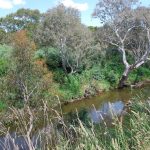 November 27, 2018 10:32 am
Published by Climate Extremes
November 27, 2018 10:32 am
Published by Climate Extremes
Bella Blanche writes about spending time on the vast Macfarlane Station in Tambo, Queensland and introduces a methodology to assess risks posed by climate change, and the vulnerability of the native rangeland resources located west of the Great Dividing Range.
 July 16, 2018 6:44 am
Published by Climate Extremes
July 16, 2018 6:44 am
Published by Climate Extremes
New research clearly demonstrates the potential to predict long-term LAI using simple ecohydrological theory. This approach could potentially be incorporated into existing terrestrial biosphere models and help improve predictions of LAI.
 July 11, 2018 11:53 pm
Published by Climate Extremes
July 11, 2018 11:53 pm
Published by Climate Extremes
This research suggests some trees and in particular, Australian trees, may be more resilient than expected to future warming and extreme events. These findings have implications for planning around which species to plant in “green cities” to help mitigate future climate extremes.
 July 6, 2018 3:43 am
Published by Climate Extremes
July 6, 2018 3:43 am
Published by Climate Extremes
The application of a simple carbon balance model, combined with a data assimilation approach, has the potential to improve the process understanding embedded in models, which is used to predict responses of the carbon cycle to climate change.
 April 17, 2018 3:49 am
Published by Climate Extremes
April 17, 2018 3:49 am
Published by Climate Extremes
In 2005 the Amazon experienced a once in a century drought. Five years later, in 2010, it was struck by an even worse drought, with even lower rainfall occurring in the dry season. However, the response of the Amazon forest to these two once-in-a-century events showed marked differences.
 March 13, 2018 11:48 pm
Published by Climate Extremes
March 13, 2018 11:48 pm
Published by Climate Extremes
Understanding which plant species can recover from drought, under what conditions and the processes involved, will help researchers predict plant mortality in response to global climate change. In response to drought, some species die because of embolism-induced hydraulic failure, while others recover, following rehydration. This research focuses on structures and processes that might allow some plants to recover from drought stress via embolism reversal.
 March 7, 2018 5:16 am
Published by Climate Extremes
March 7, 2018 5:16 am
Published by Climate Extremes
The reduction in growth of plants restricted by limitations on nutrients, temperature and/or water stress, didn't just reduce photosynthesis but led to negative feedbacks in plant carbon balance processes.







